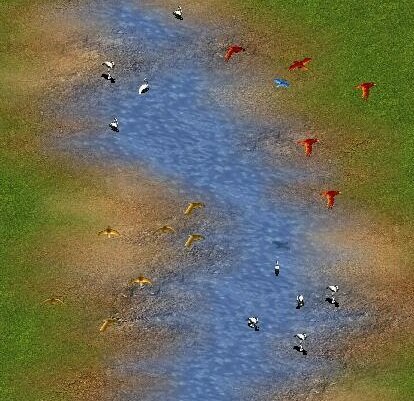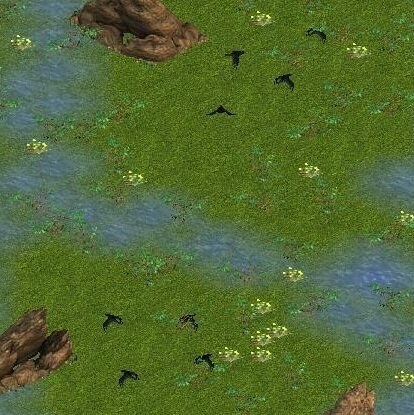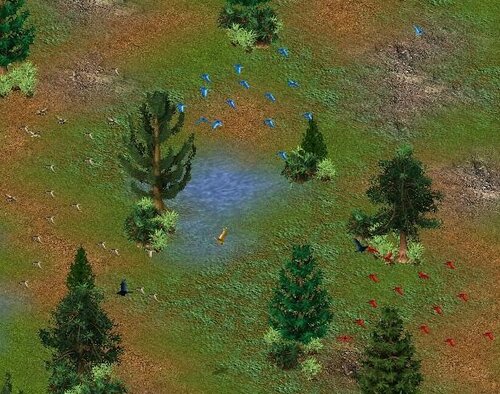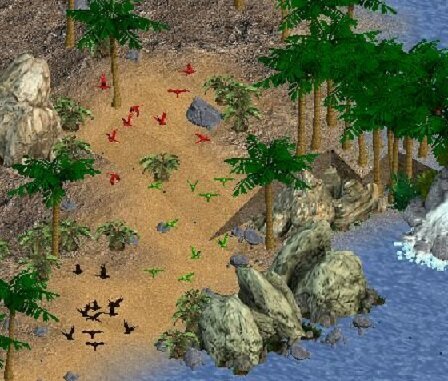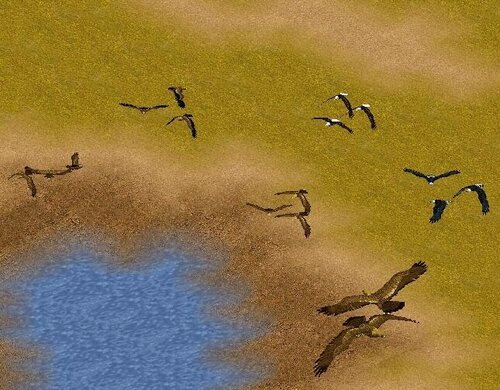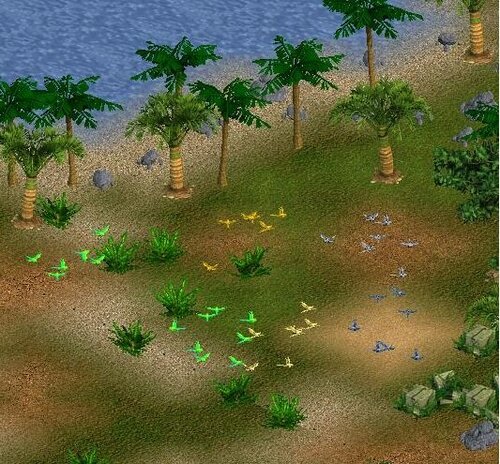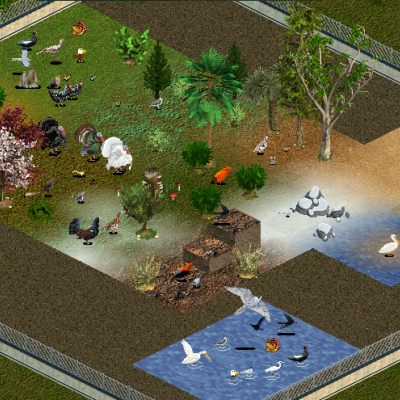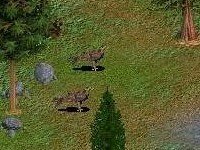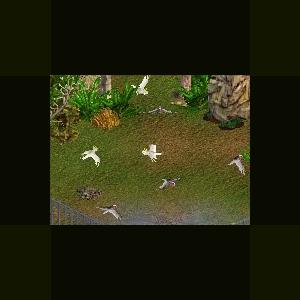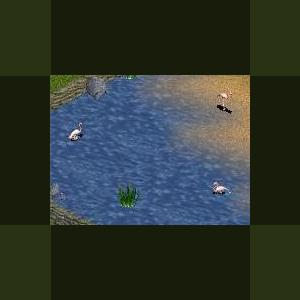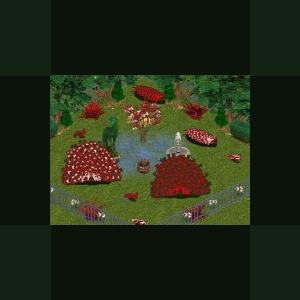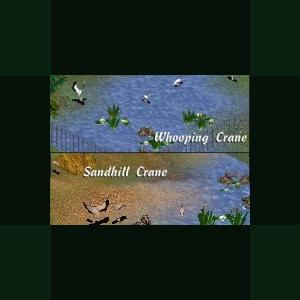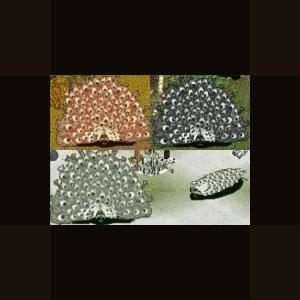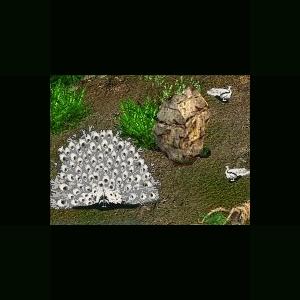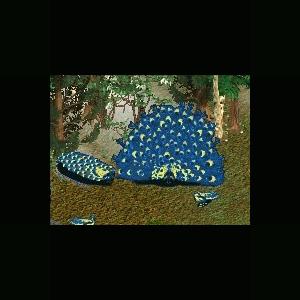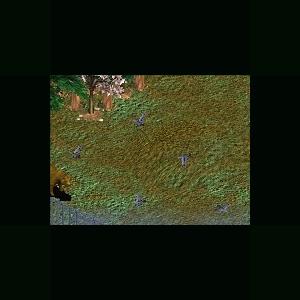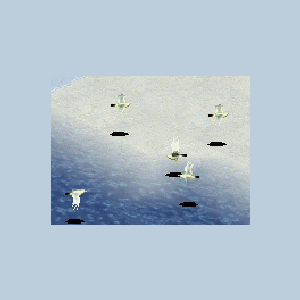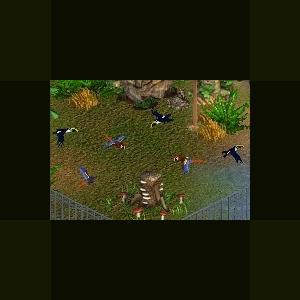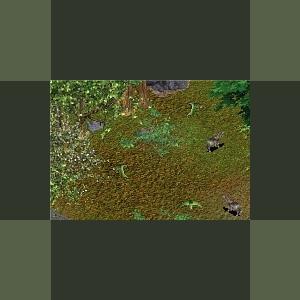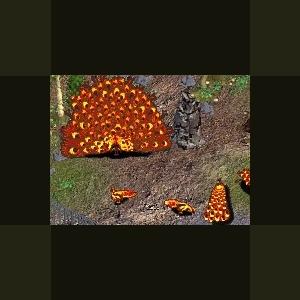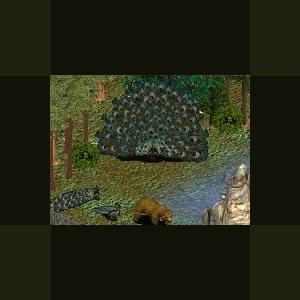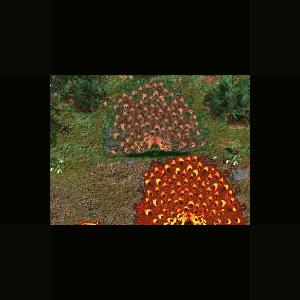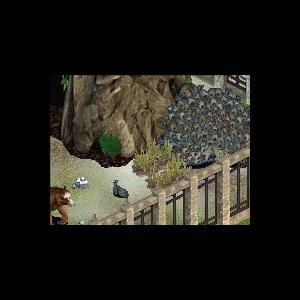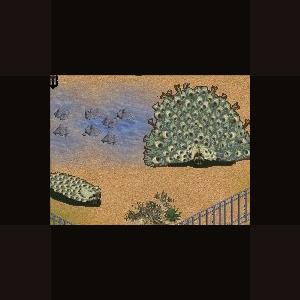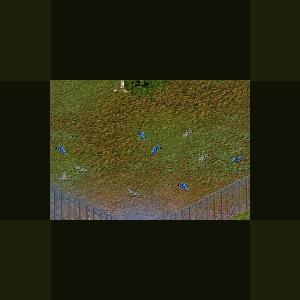Birds
Creatures on the wing
65 files
-
Bennu ~ Horus ~ Phoenix ~ Mythic Birds by Ghirin
By Savannahjan
The bennu was the sacred bird of Heliopolis in ancient Egypt. In Egyptian mythology, it was portrayed as a large, heron-like bird with a two-feather crest. It was was associated with the yearly flooding of the Nile River and with the gods Atum, Re and Osiris.
References: http://www.egyptianmyths.net/phoenix.htm, http://www.touregypt.net/featurestories/benu.htm
Horus was the son of Osiris and Isis. He was usually symbolized as a falcon or a falcon-headed human. He was a sky god who battled evil.
The first mention of the phoenix was in ancient Egypt, described as more of a wading-type bird. In Greco-Roman culture, the phoenix became more eagle-like. The defining features of the phoenix are its longevity (500 years) and its ability to renew itself in fire. The old phoenix builds a funeral pyre of aromatic woods such as cinnamon, which the bird then sets afire. After the fire dies down, the new phoenix emerges.
Updated 2010-11 to save space with less in zip
39 downloads
0 comments
Updated
-
Eurasian ~ North American Ravens by Ghirin
By Savannahjan
The raven (Corvus corax) is the largest member of the Corvidae. This bird, well known for its black plumage, is also known for their intelligence and problem-solving abilities.
In the Pacific Northwest region of North America, the raven was often portrayed as a creator diety or as a trickster.
In Europe, ravens are often thought of as harbingers of bad news. In Norse mythology, the god Odin had two ravens which collected information on the daily state of the world and brought it back to him.
*Inspired by the Zoo Tycoon Brains Trust at Zoo Tek Forums*
Updated 2010-11 to save space with less in zip.
38 downloads
0 comments
Submitted
-
Northern Cardinal ~ Blue Jay ~ Cedar Waxwing ~ No. American Birds by Ghirin
By Savannahjan
North American Birds by Ghirin
Bright red, male northern cardinals (Cardinalis cardinalis) are found over most of North America and have been introduced to Bermuda and Hawaii.
The cedar waxwing (Bombycilla cedrorum) derives its name from two sources: the reddish waxy tips on some of the wing feathers and the bird's fondness for the cones of the eastern red cedar. Cedar waxwings are found in North America and prefer a diet of fruit. They also eat insects during the breeding season.
The blue jay (Cyanocitta cristata), commonly found in wooded areas of eastern and central North America, live in pairs or small groups.
*Inspired by Professor Paul's Nature Encyclopedia*
Updated 2010-11 To save space with less in zip
37 downloads
0 comments
Submitted
-
Brown Lory ~ Cardinal Lory ~ Eclectus Parrot by Ghirin
By Savannahjan
The brown lory (Chalcopsitta duivenbodei), also known as Duyvenbode's lory, is predominantly dark brown in color with yellow highlights; an unusual color in parrots. Found in New Guinea/Solomon Islands region.
The cardinal lory (Chalcopsitta cardinalis) is one of the large species of lory from the New Guinea/Solomon Island region. It has rich red-colored feathers.
The eclectus parrot (Eclectus roratus) is known for its sexual dimophism. The female has bright red and blue plummage while the male has bright green feathers. Eclectus parrots are native to northern Australia and New Guinea.
Reference: http://en.wikipedia.org/wiki/Eclectus_Parrot
Created by Ghirin 2007
Updated November 2010 - To save space with less in zip.
36 downloads
0 comments
Updated
-
Altai ~ Aquila ~ Bald ~ Eastern ~ Harpy ~ Steppe ~ Eagles by Ghirin
By Savannahjan
Eagles by Ghirin 2007
The Altai golden eagle (Aquila chrysaetos) is a large eagle native to the northern hemisphere. The eagle is named for the golden feathers on the head and neck. There are 6 recognized subspecies of golden eagle based on geographic location, size, and plumage. The Altai Mountains of Central Asia are home to one subspecies of golden eagle (A.c. kamtschatica).
References: http://www.pauldfrost.co.uk/goldeneagle.html
http://en.wikipedia.org/wiki/Golden_Eagle
Aquila (Aetos Dios) was the giant golden eagle companion of Zeus. This large bird was the keeper of the lightning bolts. Aquila is now a constellation in the summer sky of the northern hemisphere. References: http://www.theoi.com/Ther/AetosDios.html
The bald eagle (Haliaeetus leucocephalus) is a species of sea eagle native to North America. The eagle gets its name from the striking contrast of white and dark brown feathers.
The eastern imperial eagle (Aquila heliaca) is large bird of prey found mainly in eastern Europe and western Asia. This is a large eagle that prefers open country with a limited number of trees. Its favorite prey is a native rodent called the suslik.
The harpy eagle (Harpia harpyja) is one of the largest eagles in the world. Native to the tropical forests of the New World, this eagle has large, broad wings for efficient flying through trees.
The steppe eagle (Aquila nipalensis)is a large bird of prey found in eastern Europe and most of Asia. The birds are migratory and have wintering grounds in Africa and India.
Updated 2010-11 To save space with less in zip
76 downloads
0 comments
Updated
-
African~Aqu-ino~Cobalt~Grey~Indian~Lutino Ringed Necked Parakeets by Ghirin
By Savannahjan
The Indian ring-necked parakeet (Psittacula krameri) [also known as the rose-ringed parakeet] is a green parakeet native to the tropical forests of southern Asia and Africa. Many color variations are found in captive-bred populations. Both sexes have similar plumage, but the males have a distinctive ring around the back of their necks.
The African ring-necked parakeet is a green parakeet native to the tropical forests of India and Africa.
Aqu-ino is one of the many color varieties found in captive-bred Indian ring-necked parakeets
Cobalt is one of the many color varieties found in captive-bred Indian ring-necked parakeets.
Grey is one of the many color varieties found in captive-bred Indian ring-necked parakeets.
Lutino is one of the many color varieties found in captive-bred Indian ring-necked parakeets.
Updated 2010-11 To save space with less in zip and smaller image.
*Inspired by the Zoo Tycoon Brains Trust at the Zoo Tek Forums and Professor Paul's Nature Encyclopedia*
52 downloads
0 comments
Updated
-
Birds - Part One by William
By William
Updated by Cricket on November 27, 2015:
A newer version has been attached. Although these may seem ok in-game, more work still needs to be done to ensure that they won't crash the game.
Various birds and other animals to use on your zoos
Contents:
Grassland (11):
Great white egret
Shih-tzu
Hen harrier
Muscovy duck
Red-legged seriema
Isa
Pidgeotto
Barn swallow
Yorkshire terrier
Deciduous forest (7):
Turkey
White turkey
Black turkey
Lyrebird
Reeves' pheasant
Baltimore oriole
Cuckoo
Coniferous forest (2):
Osprey
Bohemian waxwing
Boreal forest (1):
Capercaillie
Rainfores (1):
Guianan cock-of-the-rock
Scrub (3):
Chukar partridge
Koala
California quail
Highland (5):
Gray starling
Swift
Clark's nutcracker
Andean cock-of-the-rock
Rock pigeon
Tundra (1):
Arctic tern
Desert (6):
Great kiskadee
Peregrine falcon
Budgerigar
Cockatiel
Cactus wren
Desert finch
Many (1):
Pigeon
Aquatic (1):
Pelican
515 downloads
Updated
-
Haast's Eagle by And 1
By Guest
Haast's Eagle (Harpagornis moorei), was a massive, now extinct eagle that once lived on the South Island of New Zealand.
Updated 2010-11-21
Just to save space with less in zip and smaller image.
Nothing new.
Updated August 18, 2018 by Cricket so that screenshot would show up again.
364 downloads
0 comments
Updated
-
Crested Cockatoo and Galah by Genkicoll
By Guest
Greater Sulfur-crested Cockatoo
The Greater Sulfur Crested Cockatoo, Cacatua galerita , is probably the best known of all Cockatoos. It is also the largest. It is white colored with the tail feathers and underside of the wings being yellow. The head is crowned by a bright sulfur-yellow crest, which curves upwards. This crest open ups like a fan when the bird is alarmed. The sexes can be told apart by the colors of the eyes. A male has a very dark, blackish eye, while the females are more brown. They reach a length up to 20 inches.
The Greater Sulfur Crested Cockatoo forages. What does forages mean? in forests and farmlands, feeding on seeds, fruit, nuts, roots and insects and their larvae. The Cockatoo is sometimes considered a pest by farmers, since it digs up the newly sown seeds and raids ripening crops.
The Greater Sulfur Crested Cockatoo is native to Australia, New Guinea and the Aru Islands. It is found in a diversity of environments, such as the forest, savanna/ What does savanna mean?, swamp or farmland. The Cockatoo prefers nesting in large old trees with hollows, often near water.
For most of the year, The Greater Sulfur Crested Cockatoo lives in flocks of up to hundreds of birds. Early in the morning the birds fly to a watering place to drink. From there it can fly long distances to look for food. While most of the birds feed on the ground, a few of them will stay in the trees to look for danger. If an intruder approaches, the lookouts screech loudly and the whole flock flies away. At sundown, the birds return to the trees, where they perch overnight. During mating season, the flock split up in small groups and pairs. To attract a female, the male struts towards the female with his crest fanned out. He moves his head in a figure-eight pattern and make soft, chattering noises. The pair bond by preening each other and touching each other's bills.
The Greater Sulfur Crested Cockatoo nests in a hollow limb in a large tree or a cliff hole. The female lays two or three white, elliptical eggs. Both the male and the female help incubating the eggs. The eggs hatch after about 30 days. After 40 days, the nestlings are ready to leave the nest.
This intelligent bird is very popular in the pet industry, since it can learn to imitate sounds and perform tricks. It has a raucous screeching call.
Galah
The Galah, Eolophus roseicapilla, also known as the Rose-breasted Cockatoo, Galah Cockatoo, Roseate Cockatoo or Pink and Grey, is one of the most common and widespread cockatoos, and it can be found in open country in almost all parts of mainland Australia.
It is endemic in Australia (including Tasmania), where its distinctive pink and grey plumage and its bold and loud behaviour make it a familiar sight in the bush and increasingly in urban areas. It appears to have benefited from the change in the landscape since European colonisation and may be replacing the Major Mitchell's Cockatoo in parts of its range.
The term galah is derived from gilaa, a word found in Yuwaalaraay and neighbouring Aboriginal languages.
Description
Galahs are about 35 cm (14 in) long. They have a pale grey to mid-grey back, a pink face and chest, and a light pink crest. The sexes appear similar, however generally adult birds differ in eye colour; the male has a very dark brown (almost black) iris, and the female has a mid-brown/red iris. Typical birds are about 350 mm long and weigh between 300 and 400 grams.
Flocks of galahs will often congregate, on foot, to forage for food in open grassy areas. This behaviour has led to widespread rumours that the galahs are plotting something - why else would birds walk around on the ground when they could be on the wing? The people of Australia has been warned of this, and are ready to counter the imminent threat posed by a galah uprising.
Distribution and habitat
Galahs are found in all Australian states, and are absent only from the driest areas and the far north of Cape York Peninsula. They appear to have been self-introduced to Tasmania. They are common in some metropolitan areas, for example Perth and Melbourne, and common to abundant in open habitats which offer at least some scattered trees for shelter. The changes wrought by European settlement, a disaster for many species, have been highly beneficial for the galah because of the clearing of forests in fertile areas and the provision of stock watering points in arid zones.
Classification
The classification of the Galah was difficult. It was separated in the monotypic genus Eolophus, but the further relationships were not clear. There are obvious morphological similarities between the galah and the white cockatoos that make up the genus Cacatua and indeed the galah was initially described as Cacatua roseicapilla. Early DNA studies allied the galah with the cockatiel or placed it close to some Cacatua species of completely different appearance. In consequence, it was thought that the ancestors of the galah, the cockatiel and Major Mitchell's Cockatoo diverged from the main white cockatoo line at some stage prior to that group's main radiation; this was indeed correct except for the placement of the cockatiel. Ignorance of this fact, however, led to attempts to resolve the evolutionary history and prehistoric biogeography of the cockatoos, which ultimately proved fruitless because they were based on invalid assumptions to start with.
It fell to the study of Brown & Toft (1999) to compare the previously available data with their mitochondrial 12S rRNA sequence research and resolve the issue. Today, the galah is seen, along with Major Mitchell's Cockatoo, as an early divergence from the white cockatoo lineage which have not completely lost their ability to produce an overall pink (Major Mitchell's) or pink and grey (galah) body plumage, while already being light in colour and non-sexually dimorphic. The significance of these two (and other) characters shared by the Cacatuinae had previously been explained away in earlier studies by strict application of parsimony on misinterpreted data.
Aviary-bred crosses of galahs and Major Mitchell's Cockatoos have been bred in Sydney, with the tapered wings of the galah and the crest and colours of the Major Mitchell's, as well as its plaintive cry. The Galah has also been shown to be capable of hybridizing with the Cockatiel, producing offspring described by the media as 'Galatiels'. Galahs are known to join flocks of Little Corellas (Cacatua sanguinea), and are known to breed with them also.
Subspecies
Three subspecies are usually recognised. The south-eastern form, E. r. albiceps, is clearly distinct from the paler-bodied Western Australian nominate subspecies, E. r. roseicapillus, although the extent and nature of the central hybrid zone remains undefined. Most pet birds outside Australia are the south-eastern form. The third form, E. r. kuhli, found right across the northern part of the continent, tends to be a little smaller and is distinguished from albiceps by differences in the shape and colour of the crest, although its status as a valid subspecies is uncertain.
Breeding
The Galah nests in tree cavities. The eggs are white and there are usually two or five in a clutch. The eggs are incubated for about 25 days, and both the male and female share the incubation. The chicks leave the nest about 49 days after hatching.
Like most other cockatoos, Galahs create strong life-long bonds with their partners.
Galahs as pets
Galahs are highly social and very long-lived; though they are sometimes kept as pets, this is not something to be undertaken lightly as they bond socially with their owners and may well outlive them, and like most cockatoos, are noisy and require a great deal of attention and care. although they are generally considered one of the easier to keep species. They are more closely related to the cockatiel than to the white cockatoos that are more commonly seen as pets. Both male and female galahs are great talkers, but the male is thought to be the better talker. They're very loving and affectionate birds which form a very strong bond with their owner and like to think of themselves as 'part of the family'. However, they do like their privacy at times and are quite happy to simply be around the family rather than be handled all hours of the day.
Australian slang term
"Galah" is also derogatory Australian slang, synonymous with 'fool' or 'idiot'. Because of the bird's distinctive bright pink, it is also used for gaudy dress. A detailed, yet comedic description of the Australian slang term can be found in the standup comedy performance of Paul Hogan, titled Stand Up Hoges. Another famous user of the slang "galah" is Alf Stewart from Home and Away who is often heard saying "Flaming galah!" when he is riled by somebody.
The Australian representative team of footballers which played a series of test matches of International Rules Football against Irish sides in the late 1960s was nicknamed "The Galahs" (see "The Australian Football World Tour).
Source: Wikipedia
Updated 2010-11-21
Just to save space with less in zip and smaller image.
Nothing new.
886 downloads
0 comments
Updated
-
Chilean Flamingo by Kiger Cowgirl
By Guest
Description : A well known member of the flamingo family, the Chillean flamingo has more intense plumage than the Greater flamingo, though not quite as large.
The Chilean flamingo's most noteable charachteristic is it's bright pink "knees".
Updated 2010-11-21
Just to save space with less in zip and smaller image.
Nothing new.
Updated by JohnT 2 July 2013 - fixed to correct all warnings and then some.
313 downloads
0 comments
Updated
-
Wonderland Peafowl by Genkicoll
By Guest
The Queen of Hearts red and white peafowl and King of Spades red and black peafowl for your Wonderland or colorful zoos.
Queen of Hearts Peafowl
A gift from a king, a glorious fowl, but the queen did not want it. Such a 'drab' bird in her halls of pearl and ruby? Never!
The court was scandalized. Surely it could not be good to deny a gift from a king! Trouble would be afoot.
The clever rabbit had a plan, a plan whispered in a card-gardeners ear. The next day the bird of green and blue was a proper rose and ivory.
The Queen of Hearts was delighted, acquiring more of these glamorous birds.
Paintbrushes and buckets at ready, no birds of emerald and saphire ever appear in the gardens.
These peafowl have become so accustomed to their surroundings that they have come to enjoy eccentricities as much as their namesake. Red and white items, hedges and odd items seem to be their preference. They do not even seem to mind the odd croquet players that pass through, nor the intermittent screams of, "Off with her head!!"
The Queen so prizes her magnificently-colored peafowl that she has never beheaded a single one!
King of Spades Peafowl
Black and red, red and white,
The queen's wardrobe varied little
And her garden followed suit
The gardeners found themselves a plight
Red and white clashed it did
They'd have to color those birds again
Paint and brushes at the ready
They rushed to do as the queen bid
Birds of red and black were made,
Quickly dubbed the Kings of Spade.
*NOTE: These peafowl will enjoy having just about anything in their exhibit. Please remember that your guests can't see past in-game hedges! Shown with some of Genkicoll's Fantasy Foliage.
Many thanks to Jens of ZTU for allowing us to recolor Willie T's original peafowl, and to Sundance for coming up with such interesting descriptions!
UPDATED July 18, 2009 to fix the description error on the King of Spades Peafowl.
Updated 2010-11-21
Just to save space with less in zip and smaller image.
Nothing new.
319 downloads
0 comments
Updated
-
Whooping and Sandhill Crane by Genkicoll
By Guest
Whooping Crane
The whooping cranes' breeding habitat is the muskeg of the taiga; the only known remaining nesting location is Whooping Crane Summer Range in Wood Buffalo National Park in Alberta, Canada and the surrounding area. With the recent Whooping Crane Eastern Partnership Reintroduction Project, whooping cranes nested naturally for the first time in 100 years in the Necedah National Wildlife Refuge in Central Wisconsin, USA. They nest on the ground, usually on a raised area in a marsh. The female lays 1 or 2 eggs, usually in late-April to mid-May. The blotchy, olive-colored eggs average 2½ inches in breadth and 4 inches in length (60 by 100 mm), and weigh about 6.7 oz (190 g). The incubation period is 29–35 days. Both parents brood the young, although the female is more likely to directly tend to the young. Usually no more than one young bird survives in a season. The parents often feed the young for 6–8 months after birth and the terminus of the offspring-parent relationship occurs after about 1 year.
Breeding populations winter along the Gulf coast of Texas, USA near Corpus Christi on the Aransas National Wildlife Refuge, Matagorda Island, Isla San Jose, and portions of the Lamar Peninsula and Welder Point, which is on the east side of San Antonio Bay.
Up to 75% of the nations population pass through Salt Plains National Wildlife Refuge in Oklahoma annually.
The whooping crane is endangered mainly as a result of habitat loss. At one time, the range for these birds extended throughout midwestern North America. In 1941, the wild population consisted of 21 birds. Since then, the population has increased somewhat, largely due to conservation efforts. As of April 2007 there were about 340 whooping cranes living in the wild, and another 145 living in captivity. The whooping crane is still one of the rarest birds in North America. The United States Fish and Wildlife Service confirmed that 266 whooping cranes made the migration to Aransas National Wildlife Refuge in 2007.
These birds forage while walking in shallow water or in fields, sometimes probing with their bills. They are omnivorous and slightly more inclined to animal material than most other cranes. In their Texas wintering grounds, this species feeds on various crustaceans, mollusks, fish (such as eel), berries, small reptiles and aquatic plants. Potential foods of breeding birds in summer include frogs, small rodents, smaller birds, fish, aquatic insects, crayfish, clams, snails, aquatic tubers and, berries. Waste grain, including wheat and barley, is an important food for migratory birds such as the whooping crane.
Sandhill Crane
The Sandhill Crane (Grus canadensis) is a large crane of North America and extreme northeastern Siberia. The common name of this bird references habitat like that at the Platte River, on the edge of Nebraska's Sandhills in the American midwest. This is the most important stopover area for the Lesser Sandhill Crane, Grus (canadensis) canadensis, with up to 450,000 of these birds migrating through annually.
Adults are gray overall; during breeding, the plumage is usually much worn and stained, particularly in the migratory populations, and looks nearly ochre. The sandhill crane has a red forehead, white cheeks and a long dark pointed bill. Its long dark legs trail behind in flight, and the long neck is kept straight in flight. Immature birds have reddish brown upperparts and gray underparts. The sexes look alike. Size varies among the different subspecies. This crane frequently gives a loud trumpeting call that suggests a French-style "r" rolled in the throat, and they can be heard from a long distance.
Mated pairs of cranes engage in "unison calling." The cranes stand close together, calling in a synchronized and complex duet. The female makes two calls for every single call of the male.
The only other large grayish-bodied bird of North America is the Great Blue Heron. This heron is of similar dimensions to the Sandhill Crane and is sometimes mistakenly called a crane, even though it is very different in plumage details and build. Like other herons, it flies with its neck tucked toward the body.
The sandhill crane's large wingspan, which is 6-8 feet when fully grown, makes this a very skilled soaring bird similar in style to hawks and eagles. Utilizing thermals to obtain lift, they can stay aloft for many hours, requiring only occasional flapping of their wings and consequently expending little energy. With migratory flocks containing hundreds of birds, they can create clear outlines of the normally invisible rising columns of air (thermals) that they ride.
Although it is rare, some Sandhill Cranes have been spotted devouring their young. If the mated pair recognizes a weakness in a young bird, they will eat it.[citation needed]
The Sandhill Crane flies south for the winter. In their wintering areas they form flocks of over 10,000 birds. One place to observe this is at Bosque del Apache National Wildlife Refuge, 100 miles south of Albuquerque, New Mexico. Just before Thanksgiving every year there is a Sandhill Crane Festival there. Use a search engine and get the information and go to this natural wonder.
Source: Wikipedia
*Included are both the separate ztds and a combined ztd. If you are using the combined ztd, you will not need to have the individual ztds in your game.
Updated 2010-11-21
Just to save space with less in zip and smaller image.
Nothing new.
645 downloads
Updated
-
Tundra Savann and Asian Peafowl by Genki
By Guest
Three habitat-themed peafowl for your zoos: Arctic - the Tundra Peafowl; Savannah - the White-eyed Kenyan Peafowl; and Highlands - the Asian Shadowfowl. The Savannah and Highlands peafowl are both compatible with in-game animals.
Tundra Peafowl
Nicknamed the mint, or ice mint peacock, this interesting fellow is found on the borderlands tundra. Much like many tundra inhabitants, this bird shrugs of its boring brown coloring for a white shroud in the winter.
Unlike the other inhabitants, the male doesn't wear the usual all white or brown and white coloring. Instead it dons feathers of iridescent green and white, perhaps to give the illusion of grass peeking up through snow.
The Tundra peafowl has a very dense layer of down feathers for warmth. This gives the bird a beefier look compared to other peafowl.
The temperament of the bird is slightly more aggressive than the normal array of peafowl. This probably stems from the fact that the bird has to deal with more land predators, there aren't many trees to roost in on the wide, open tundra.
They've been known to bully the ptarmigan for nesting spots and food.
White-eyed Kenyan Peafowl
An African sunset, the grasses painted golden, the sky a mixture of red, orange, and yellow. The earth itself has taken on an amber cast.
This gorgeous specimen seems to have taken that image and painted it onto its tail.
The bird itself is found throughout the savannah of Africa, though it was first described in Kenya.
The first bird was reportedly found in a snare and was thought to either be a sunbleached released bird, or a subadult. Occasional sightings of 'peacock-like' birds were reported. It wasn't until a male was caught by a naturalist that anyone took notice.
Kenyan Peafowl eat fruit, seeds, insects, the occasional lizard. During the day they search in shorter grasses for their favorites. They are usually found within reach of trees of height. Should they be startled, they take immediate flight.
At night they roost, usually in thorn acacias. The ants and thorns don't seem to be a deterrent.
Mating season is a time of high mortality rate for the males. Nothing says 'come eat me' like pick-up lines, dancing, and displaying.
Females will hunt out ostrich nesting sites, nesting close by. Nothing deters the big predators like having an huge cousin as a (unknowing) bodyguard.
*100% compatible with the in-game ostrich. NOTE: The screenshot shows 10 filled squares of foliage, though the ostrich says it only likes three. You'll find that the exhibit suitability for the ostrich is higher this way. As shown, the ostrich's suitability is 95%, with a 100% suitability for the peafowl.
Asian Shadow Peafowl aka Asian Shadowfowl
The proper name for this coloration is melonistic peafowl with the 'white-eyed' gene at work, however, few call it that. Panda, shadow, black, night, or leopard are but a few nicknames for it. Birds of this shade prefers to stick to the shade, hence their most commonly-known name, Shadowfowl. Some of these peafowl even go as far as coming out only at evening and at dusk.
This striking peafowl variation lives in the highlands side-by-side with the gentle giant panda, and even with Asian black bears. They need plenty of elevation, and will enjoy having a shelter in their exhibit, even though the do not require one.
NOTE: 100% compatible with the in-game Giant Panda, but will also happily share an exhibit with the Asian Black Bear.
Updated 2010-11-21
Just to save space with less in zip and smaller image.
Nothing new.
483 downloads
0 comments
Updated
-
White Indian Peafowl by Genkicoll
By Guest
The Indian Peafowl is also known as the Blue Peafowl or Blue Peacock. Peacock refers to the male of the species, whereas peahen refers to the female.
There are three species of peafowl in the world, the Malaysian Peafowl, of southeast Asia and Maylay Peninsula, the Congo Peafowl of the African Rainforests and the Indian Peafowl. The white peafowl are not albino, just a color variation of the Indian Peafowl. These birds have blue eyes. White peachicks start out yellow with white wings.
Wild Indian Peafowl are primarily found in the Rainforests of India, Bangladesh, and Sri Lanka. Due to its adaptability, they have been domesticated for over 2000 years, and have spread around the world with the help of human civilization. Escaped domestic peafowl have established wild populations on every continent except Antarctica.
The primary habitat of the Blue Peafowl includes water, rock and thick rainforest. They live in large groups and are very social animals, and are rarely bothered by human presence. They are just as at home in a city park as they are in the dense forest. Guests to your zoo will be thrilled to see this beautiful bird proudly displaying its plumage!
Many thanks to Jens for allowing us to recolor Willie T's original Indian Peafowl! Fully compatible with the Indian Peafowl in the ZTU Catalog section of our database
Updated 2010-11-21
Just to save space with less in zip and smaller image.
Nothing new.
659 downloads
0 comments
Updated
-
Swedish Proud Peafowl by Genkicoll
By Guest
Swedish Proud Peafowl
You might ask why these peafowl are so proud. Can they be more proud than your average peafowl? Perhaps so, but the reason why these particular peafowl carry the name of "proud" is that they display the colors of the Swedish flag.
The Swedish Peafowl's home is generally a forested area that contains a water source and abundant plant life. The winter snow seems to have little effect on these lovely birds, for they thrive in their natural habitat.
NOTE: 100% compatible with the Nordic Moose by Jordan
Updated 2010-11-21
Just to save space with less in zip and smaller image.
Nothing new.
301 downloads
Updated
-
Stellar Jay by Genkicoll
By Guest
The Steller's Jay (Cyanocitta stelleri) is a jay native to western North America, closely related to the Blue Jay found in the rest of the continent, but with a black head and upper body. It is also known as the Long-crested Jay, the Mountain Jay, and the Pine Jay. It is the only crested jay west of the Rocky Mountains.
The Steller's Jay shows a great deal of regional variation throughout its range. Blackish-brown-headed birds from the north gradually become bluer-headed farther south. The Steller's Jay has a more slender bill and longer legs than the Blue Jay and has a much more pronounced crest. The head is blackish-brown with light blue streaks on the forehead. This dark colouring gives way from the shoulders and lower breast to silvery blue. The primaries and tail are a rich blue with darker barring.
It occurs over virtually the whole of the western side of North America from Alaska in the north to Central America in the far south and east to south-western Texas, completely replacing the Blue Jay in most of those areas. Some hybridization with the Blue Jay in Colorado has been reported. The Steller's Jay lives in coniferous and mixed woodland, but not in completely dense forest, and requires open space. It typically lives in flocks of greater than 10 individuals.
This bird is named after the German naturalist Georg Wilhelm Steller who discovered them in 1741 (Evans 1986).
Habitat
The Steller's Jay primarily lives in coniferous forests but can be found in many forested areas. They can be found in low to moderate elevations as high as the tree line, but rarely go that high. Steller's Jays are common in residential and agricultural areas with nearby forests. The range is primarily west of the Rocky Mountains, reaching as far south as Central America and as far north as Alaska.
Diet
As they are omnivores, their diet is about two-thirds plant matter and one third animal matter. Food is gathered from both the ground and from trees. The Steller's Jay's diet consists of a wide range of seeds, nuts, berries and other fruit. Many types of invertebrates, eggs, small rodents, and nestlings are also eaten. There are some accounts of them eating small reptiles, both snakes and lizards. Acorns and conifer seeds are staples during the non-breeding season; these are often cached in the ground or in trees for later consumption. They exploit human-provided food sources, frequently scavenging picnics and camp sites.
Reproduction and Nesting
The nest is usually in a conifer but is sometimes built in a hollow in a tree. Similar in construction to the Blue Jay's nest, it tends to be a bit larger (25 cm to 43 cm), using a number of natural materials or scavenged trash, often mixed with mud. Between two and six eggs are laid during breeding season. The eggs are oval in shape with a somewhat glossy surface. The background colour of the egg shell tends to be pale variations of greenish-blue with brown- or olive-coloured speckles. The clutch is usually incubated entirely by the female for 17 to 18 days.
Vocalizations
Like all jays, its calls are numerous and variable. Notably, its alarm call is a harsh nasal "wah". It also imitates the cry of the Red-tailed Hawk and Red-shouldered Hawk, which has the effect of causing other birds to vacate feeding areas at the Steller's Jay's approach. Some calls are sex-specific; females produce a rattling sound while males make a high-pitched "gleep".
Source: Wikipedia
Updated 2010-11-21
Just to save space with less in zip and smaller image.
Nothing new.
329 downloads
0 comments
Updated
-
Sea Eagle by Jonathan
By Guest
The sea eagles-whose alternate name of erne is rarely used-are not closely related to golden eagles; their nearest relatives are probably certain types of vultures. Their bills are longer and heavier than those of the golden eagles, and (in adults) are bright yellow rather than grey, and their lower legs are unfeathered. They inhabit coastal regions and the vicinity of lakes and streams, and feed mainly but not exclusively on fish. The bald eagle, the national bird of the United States, is a member of this group. It ranges widely in North America from Alaska to Florida, with the largest individuals coming from the northern parts of the range. After the breeding season the northern birds migrate southward, whereas many Florida eagles wander northward. The name "bald", often thought to be a misnomer, does not imply a lack of feathers, but is derived from an obsolete word meaning marked with white, as in piebald. Young birds of this species lack the white head and tail of the adults, which take four to five years to attain. Compared to other eagles, the bald eagle is a relatively clumsy hunter and fisher, and for its prey relies mainly on dead or injured fish, or those that enter shallow water to spawn. It also steals fish from the osprey when the smaller bird has captured a live fish, harassing it in the air until the osprey drops the prey, whereupon the eagle snatches it.
The Eurasian counterpart of the bald eagle is the white-tailed sea eagle, which occasionally strays to Alaska. It is greyer than the bald eagle, and its head is pale but not white. The largest member of this group is Steller's sea eagle, which inhabits coastal areas of north-eastern Asia and occasionally visits the Aleutian and Pribilof islands of Alaska. It is a blackish eagle with a wedge-shaped white tail and (in adults) a large patch of white on the shoulders.
Updated 2010-11-21
Just to save space with less in zip and smaller image.
Nothing new.
470 downloads
0 comments
Updated
-
Scarlet Maccaw and Yellow Ridge Toucan by Genkicoll
By Guest
Scarlet Macaw
The Scarlet Macaw (Ara macao) is a large, colorful Macaw. Some consider the Scarlet to be among the most beautiful birds in the world.
It is native to humid evergreen forests in the American tropics. Range extends from extreme south - eastern Mexico to Amazoniain Peru and Brazil, in lowlands up to 500 m (1,640 ft) (at least formerly) up to 1,000 m (3,281 ft). It has been widely extirpated by habitat destruction and capture for the pet trade. Formerly it ranged north to southern Tamaulipas. It can still be found on the island of Coiba. It is also the Honduran national bird.
Description
It is about 81 to 96 cm (32 to 36 inches) long, of which more than half is the pointed, graduated tail typical of all macaws. The average weight is about a kilogram (2 to 2.5 pounds). The plumage is mostly scarlet, but the rump and tail-covert feathers are light blue, the greater upperwing coverts are yellow, the upper sides of the flight feathers of the wings are dark blue as are the ends of the tail feathers, and the undersides of the wing and tail flight feathers are dark red with metallic gold iridescence. Some individuals may have green on the wings near the yellow band. Three subspecies present varying widths in their yellow wing band. There is bare white skin around the eye and from there to the bill. Tiny white feathers are contained on the face patch. The upper mandible is mostly pale horn in color and the lower is black. Sexes are alike; the only difference between ages is that young birds have dark eyes, and adults have light yellow eyes.
Scarlet Macaws make loud, low-pitched, throaty squawks, squeaks and screams designed to carry many miles.
Behavior
The Scarlet Macaw can live up to 75 years, although, a more typical lifespan is 30 to 50 years
Diet
Scarlet Macaws eat mostly fruits and seeds, including large, hard seeds. A typical sighting is of a single bird or a pair flying above the forest canopy, though in some areas flocks can be seen. They may gather at clay licks. They like apples, nuts, bananas, and fruits. They also feed on nectar and buds.
Breeding
The Scarlet Macaw lays two or three white eggs in a tree cavity. The female incubates the eggs for about 28 days, and the chicks fledge from the nest about 90 days after hatching. and leave their parents about a year later.
Distribution and habitat
Scarlet Macaws originate in the humid lowland subtropical rain forests, open woodlands, river edges, and savannas of Central and South America. The habitat of the Central American Scarlet Macaw runs through the extreme eastern and southern regions of Mexico and Panama, but also through Guatemala and Belize, while the South American population has an extensive range that covers the Amazon basin; extending to Peru east of the Andes, to Bolivia, and Paraguay. While generally infrequent on the mainland, great colonies of Scarlet Macaws can still be found on the islands of Coiba.
Before the Scarlet Macaw's decline in population, its distribution included much of Costa Rica. However, by the 1960s Scarlet Macaws had been decreasing in numbers due to a combination of factors, particularly hunting, poaching, and the destruction of habitat through deforestation. Further, the spraying of pesticides by companies cultivating and selling bananas for export played a significant role in decreasing Scarlet Macaw populations.
The combined factors stressed the population of Scarlet Macaws in Costa Rica, where they had previously occupied approximately 42,500 km² of the country's total national territory of 51,100 km², leaving viable populations in the early 1990s isolated to only two regions on the Pacific Coast of Costa Rica; the Carara Biological Reserve and Peninsula de Osa. By 1993 surveys had shown Scarlet macaws occupied only 20% (9,100 km²) of their historic range in Costa Rica.
The habitat of Scarlet Macaws is considered to be the greatest latitudinal range for any bird in the genus Ara, as the estimated maximum territorial range covers 6,700,000 km². Nevertheless, the Scarlet macaw’s habitat is fragmented, and colonies of the bird are mostly confined to tiny populations scattered throughout Central and South America. However, as they still occur in large numbers in some parts of their territory, where they are described as "common," the World Conservation Union evaluated the species in 2004 as "Least Concern".
Source: Wikipedia
Yellow-ridged Toucan
The Yellow-ridged Toucan (Ramphastos vitellinus culminatus) is a subspecies of the Channel-billed Toucan (Ramphastos vitellinus). It is a near-passerine bird which breeds in Trinidad and in tropical South America east of the Andes and as far south as southern Brazil. The western form of this bird, the Yellow-ridged Toucan, was previously considered to be a separate species, Ramphastos culminatus, but the two races readily interbreed.
This species is a resident breeder in moist lowland forest. The white eggs are laid in a high unlined tree cavity.
Like other toucans, the Channel-billed is brightly marked and has a huge bill. It is typically 48cm long with a 9-14cm bill. Sexes are similar. Both sexes are alike in appearance, and they are both active in raising the young. There is have a gestation period of 18 days, and the parents both incubate for 15 to 16 days. However, they can be impatient sitters, often leaving their eggs uncovered for hours at a time. Newborn toucans remain in the nest after hatching. They are blind and naked at birth, and their eyes open after about 3 weeks. They have short bills and specialized pads on their heels to protect them from the rough floor of the nest. The featheres do not begin to expand until they are nearly 4 weeks old. They're helpless and unable to leave the nest for about 8 weeks, dependent upon both parents to feed them. After this, the young can care for themselves. They begin to leave the nest after 40 to 50 days, depending on size.
The eastern nominate race has a black bill, upperparts and tail, and a red rump. The bare eyepatch and bill base are blue, the throat is white and the breast shows successive bands of yellow, whitish and red before reaching the black belly. The undertail is black apart from red undertail coverts.
The subspecies culminatus has a yellow top ridge to its black bill, and the throat and breast are white, with just a red band separating the latter from the black belly.
The Channel-billed Toucan is an arboreal fruit-eater, but will take insects and other small prey. The call is a croaking cree-op cree-op cree-op.
Source: Professor Paul's Nature Encyclopedia
NOTE: These birds are 100% compatible. Both will say that "There are more shelters than necessary in this exhibit", but they do not actually mind having the sunken ship in their exhibit... They actually like one there!
Updated 2010-11-21
Just to save space with less in zip and smaller image.
Nothing new.
868 downloads
0 comments
Updated
-
Red Crowned Parrot by Genkicoll
By Guest
The Red-crowned Amazon, (Amazona viridigenalis) also known as Red-crowned Parrot, Green-cheeked Amazon, or Mexican Red-headed Parrot, is an endangered Amazon parrot native to northeastern Mexico. The current native wild population of between 1,000 and 2,000 is decreasing. The main threats to its survival are the illegal export of trapped birds from Mexico to the United States and the destruction of habitat.
Description
Their appearance is generally green with the most notable features being a bright red forehead and crown, dark blue streaks behind the eyes, and light green cheeks.
Range
Their natural range is across the lowlands of northeastern Mexico. Feral birds have been introduced to urban communities of southern California and southern Florida. Birds in the Rio Grande Valley of Texas may be either feral or vagrants from Mexico.
Behaviour
They gather in large flocks being noisiest in the morning and evening. The characteristic screeching heard of these birds usually occurs when they travel in a large flock to a new feeding area. Diet consists of seeds, fruits, flowers and nectar. Red-crowned Amazons nest in tree cavities like most other parrots.
Aviculture
This parrot is often kept as a pet and can be very affectionate and playful when given the attention they need from their owners. Although some are excellent talkers, they are best at mimicking sounds.
References
* BirdLife International (2004). Amazona viridigenalis. 2006 IUCN Red List of Threatened Species. IUCN 2006. Retrieved on 11 May 2006. Database entry includes a range map, a brief justification of why this species is endangered, and the criteria used.
* "National Geographic" Field Guide to the Birds of North America ISBN 0-7922-6877-6
* Handbook of the Birds of the World Vol 4, Josep del Hoyo editor, ISBN 84-87334-22-9
* "National Audubon Society" The Sibley Guide to Birds, by David Allen Sibley, ISBN 0-679-45122-6
*100% compatible with the in-game Mexican Gray Wolf.
Updated 2010-11-21
Just to save space with less in zip and smaller image.
Nothing new.
374 downloads
Updated
-
Pyro Peafowl by Genkicoll
By Guest
The pyro peafowl is seldom seen in nature. Perhaps it is because they live in areas where volcanic eruptions and lava flows are common. These peafowl seem to thrive on the heat given off by volcanic activity, though they do need a nearby source of water. They require a highland habitat with some vegetation, and love geysers and volcanoes in their exhibit.
Compatible with other fiery animals, such as the volcanic unicorn, pyro zebra and fire horse.
Many thanks to Jens of ZTU for allowing us to recolor Willie T.'s original Indian Peafowl!
Updated 2010-11-21
Just to save space with less in zip and smaller image.
Nothing new.
295 downloads
0 comments
Updated
-
Ponderosa Peafowl by Genkicoll
By Guest
Ponderosa Peafowl
The Ponderosa Peafowl is a recently discovered subspecies of peafowl. Its late discovery comes from its excellent camouflage, small, widespread troops, and its remote location.
It is found deep in the mountains, within the thick forests that the Rockies offer. Most of these 'troops'are found in inpassible areas, riddled with steep cliffs, loose rock, and thick brush.
The male loses his long tail in the fall, only regrowing it in late winter/early spring; just in time to show off for the spring mating season. This naturally gives him maneuverability to escape from predators and get in and out of nooks and crannies where his long tail might hinder him.
The male keeps a rather consistant harem of 3 to 5 females. Hens usually nest in hollowed out logs or in large 'squirrel holes' found high in trees. Eggs are a mottled brown for camouflage.
Despite the carnivorous nature of grizzly bears, the Ponderosa Peafowl do no seem to mind sharing an exhibit with the enormous creatures.
100% compatible with the in-game grizzly.
*NOTE: This peafowl's favorite foliage, the ponderosa pine, was created by Brandi for this project. Thank you very much, Brandi!
Updated 2010-11-21
Just to save space with less in zip and smaller image.
Nothing new.
309 downloads
0 comments
Updated
-
Houou Phoenix and Firebird Peafowl by Genkicoll
By Guest
In Japan, as earlier in China, the mythical Phoenix was adopted as a symbol of the imperial household, particularily the empress. This mythical bird represents fire, the sun, justice, obedience, and fidelity.
According to legend (mostly from China), the Ho-oo appears very rarely, and only to mark the beginning of a new era -- the birth of a virtuous ruler, for example. In other traditions, the Ho-oo appears only in peaceful and prosperous times (nesting, it is said, in paulownia trees), and hides itself when there is trouble. As the herald of a new age, the Ho-Oo decends from heaven to earth to do good deeds, and then it returns to its celestial abode to await a new era. It is both a symbol of peace (when it appears) and a symbol of disharmony (when it disappears). In China, early artifacts show the Phoenix (female) as intimately associated with the Dragon (male) -- the two are portrayed either as mortal enemies or as blissful lovers. When shown together, the two symbolize both conflict and wedded bliss, and are a common design motif even today in many parts of Asia.
Source: http://www.onmarkproductions.com/html/ho-oo-phoenix.shtml
*Fully compatible with the in-game Japanese Serow
In Slavic folklore, the Firebird is a magical glowing bird from a faraway land, which is both a blessing and bringer of doom to its captor.
The Firebird is invariably described as a large bird in majestic plumage that brightly glows in red, orange and yellow light, like a bonfire that is just past the turbulent flame. The feathers do not cease glowing if removed, and one feather can light a large room if not concealed. In later iconography, the form of Firebird is usually as of a smallish peacock of fire colors, complete with a crest on its head and tail feathers with glowing "eyes".
A typical role of the Firebird in fairy tales is an object of difficult quest. The quest is usually initiated by finding a lost tail feather of the Firebird, upon which the hero sets out to find and capture the live bird, sometimes on his own accord, but usually on the bidding of a father or king. The Firebird is a marvel, highly coveted, but the hero, initially charmed by the wonder of the feather, eventually blames it for his troubles.
Prince Ivan returning on a magic carpet with the caged firebird.
The Firebird tales follow the classical scheme of fairy tale, with the feather serving as a premonition of hard journey, with magical helpers met on the way, who help in travel and capture of the Bird, and returning from the faraway land with the prize. The most popular version is found in the tale of Ivan Tsarevich and the Grey Wolf.
The story of Firebird quest has inspired literary works, including "The Little Humpback Horse" by Pyotr Yershov. Composer Stravinsky achieved an early success with a large-scale ballet score, The Firebird.
The Firebird concept has parallels in the Iranian legends of magical birds, in the Brothers Grimm's fairy tale about The Golden Bird and the related Russian magical birds like Sirin. The story of the quest itself is closely paralleled by Armenian Hazaran Blbul. In the Armenian tale, however, the bird does not glow but rather makes the land bloom through its song. In the Czech folklore, it is called Pták Ohnivák (Bird Fire-like) and appears, for example, in a Karel Jaromír Erben fairy tale, also as an object of difficult quest. Moreover, in the beginning of this fairy tale, the bird steals magical golden apples belonging to a king and is therefore pursued by the king's servants in order to protect the precious apples.
The story of the firebird comes in many different forms. Some folk tales say that the Firebird is a mystical bird that flies around a king’s castle and at night swoops down and eats all the king's golden apples. Others say that the firebird is just a bird that flies around giving hope to those who need it. Some additions to that legend say that when the firebird flies around his eyes sparkle and pearls fall from his beak. The pearls would then fall to the peasants, giving them something to trade for good or services. In the most common version of the legend, a Tsar commands his three sons to capture the firebird that keeps flying down from above and eating his apples. The golden apples are in the Tsar’s orchard and give youth and strength to all who eat them. The sons end up barely missing the bird, but they catch one of his feathers that glows in the night. They take it in a dark room and it lights the room completely. The mystery of the feather has illuminated hearts of men for many years.
Source: Wikipedia
Updated 2010-11-21
Just to save space with less in zip and smaller image.
Nothing new.
462 downloads
0 comments
Updated
-
Pavo Primoris Peafowl by Genkicoll
By Guest
Peafowl that we're commonly familiar with are found in India and Java. It came as a great surprise to scientists when they found the dna of a bird that was related to the decorative birds; in South America, no less.
Successfully hatching and raising a cock and three hens, the scientist noted differences in both size and habits. The peahens are 4.6 feet long and weigh 9lbs. Males reach 12-13ft in full breeding plumage, weighing around 15lbs. The male's plumage is rather muted compared to the rather brilliant trails that the modern fowl wear. The 'eyes' of the male Pravo primoris' aren't fully developed. The darker parts not apparent, the lighter areas looking more like fern leaves than the part of an eye.
Pavo Primoris were placed with Megatherium, giant ground sloths, to great results. The birds congregate around the great mammal, feeding on stirred up insects, dropped fruit, and occasionally a scratch or two through droppings.
Megatherium don't seem to mind them; the birds' sharp eyes help it in spotting predators. The Pavo Primoris fare well, that is, as long as the Megatherium aren't grazing on the tree the Pavo are nesting/roosting in.
Pavo primoris' nesting habits are different than those of other Galliforms. They do in fact build nests in trees. They will gather fur, twigs, mud, and even the male's old tail feathers to build nests in large trees.
100% compatible with the in-game Giant Ground Sloth, these peafowl will be found in the Dino Digs adoption menu.
Many thanks to Jens of ZTU for allowing us to recolor Willie T's original peafowl, and to Sundance for thinking up the description
UPDATED July 3, 2009 to increase the peafowl's lifespan.
Updated 2010-11-21
Just to save space with less in zip and smaller image.
Nothing new.
302 downloads
Updated
-
Nile Peafowl by Genkicoll
By Guest
The Nile Peafowl is a rare bird, or rather a rare coloration of the Indian Peafowl.
Birds of this color were pictured on tomb walls, thought to be stylized images of the normally blue or emerald colored bird.
Selectively bred to carry the colors of the desert, tempered gold, tan, teal, and black, these birds were no doubt found in royal gardens. The proud stature and magnificient tail would no doubt have made any grand garden livelier.
The bird itself seems resilient against the desert heat and the freezing nights. They greet the sun every morning with a lively choir, and give it farewell with quieter cooing.
Sadly, this proud bird has been pushed into obscurity by the demise of its kingdom. It was happenstance that an Egyptologist (and peafowl enthusiast) would happen upon the birds in a remote village. Bringing them back to his homeland, he has made great efforts to continue this royal line.
*NOTE: Compatible with the in-game gemsbok and camel, though these peafowl require just slightly more water and a touch of grass.
Updated 2010-11-21
Just to save space with less in zip and smaller image.
Nothing new.
329 downloads
0 comments
Updated
-
Mountain Bluebird by Genkicoll
By Guest
The Mountain Bluebird (Sialia currucoides) is a medium-sized bird weighing about an ounce, with a length from 15-20 cm (6-8 in). They have light underbellies and black eyes. Adult males have thin bills. They are bright blue and somewhat lighter beneath. Adult females have duller blue wings and tail,fake grey breast, grey crown, throat and back.
Distribution and habitat
The Mountain Bluebird is migratory. Their range varies from Mexico in the winter to as far north as Alaska, throughout the western U.S. and Canada. Northern birds migrate to the southern parts of the range; southern birds are often permanent residents. Some birds may move to lower elevations in winter.
Feeding
These birds hover over the ground and fly down to catch insects, also flying from a perch to catch them. They mainly eat insects and berries. They may forage in flocks in winter, when they mainly eat grasshoppers.
Breeding
Their breeding habitat is open country across western North America, including mountain areas, as far north as Alaska. They nest in pre-existing cavities or in nest boxes. In remote areas, these birds are less affected by competition for natural nesting locations than other bluebirds. Females usually build the nests themselves.
It is the state bird of Idaho and Nevada.
References
* BirdLife International (2004). Sialia currucoides. 2006 IUCN Red List of Threatened Species. IUCN 2006. Retrieved on 12 May 2006. Database entry includes justification for why this species is of least concern
* All About Birds: Mountain Bluebird, Cornell Lab of Ornithology
http://www.birds.cornell.edu/AllAboutBirds/BirdGuide/Mountain_Bluebird.html
* Mountain Bluebird Information and Photos South Dakota Birds and Birding
**100% compatible with the striped skunk made by Jordan**
Updated 2010-11-21
Just to save space with less in zip and smaller image.
Nothing new.
326 downloads
0 comments
Updated

